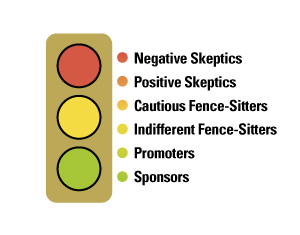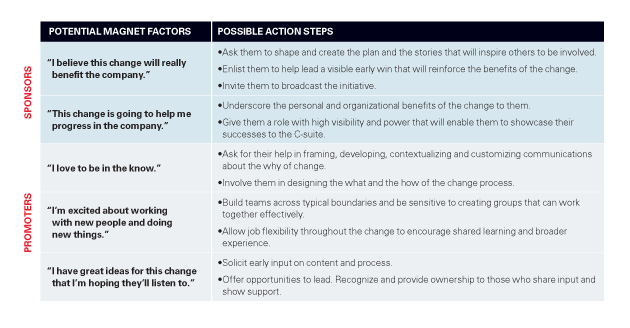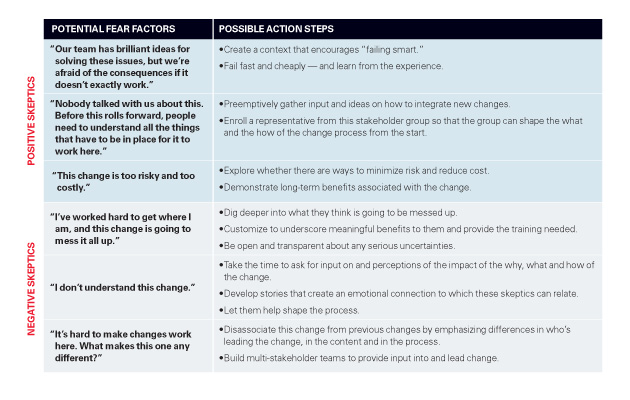Navigating the Politics and Emotions of Change
Even the most sensible change initiatives can flounder if emotions and political dynamics within an organization are ignored. But a five-step process can proactively address these “softer” factors — and enable successful change.
Topics
In today’s fast-paced economy, leaders know that their organization’s success may be tightly linked to its ability to change and change again — and again. Most executives have a portfolio of tools that they use for developing their strategic plans, structure, metrics and other “hard aspects” of change. However, their approach to tackling the “softer side of change” and, more specifically, navigating the politics and emotions associated with change, is often more unstructured.
Yet left unattended, skepticism, fear and panic can wreak havoc on any change process. These types of feelings can create resistance, disengagement, distraction and burnout. Innovative ideas may get suffocated, time and energy wasted, and change goals sacrificed to short-term self-interest. Performance may also drop as exasperated high-performing employees leave for calmer seas. As consultants, called in afterward to clean up the wreckage, we often hear things like:
“It seemed like the new sustainability initiative was ready to be launched and that we would roll it out full steam ahead. Then there was push-back from the suppliers and the staff lost faith that it would ever work.”
“The merger integration never really happened. Both companies held onto their ways of doing things, and politics paralyzed the process. All the best talent bailed and the value of the company tanked.”
“Fear of this technology switchover was rampant, and before we knew it, the whole thing ground to a halt.”1
After listening to dozens of similar stories, we began to recognize an underlying pattern in these failures. Working with executives both as consultants and in more than 400 change projects conducted as part of the Kellogg/Schulich Executive MBA program, we developed a practical approach for systematically navigating and leveraging the politics and emotions that naturally arise in every major change. (See “About the Research.”)
Leveraging Politics and Emotions
The five-step process we introduce here is designed to enable change leaders to successfully navigate the politics and emotions of change by identifying and leveraging the expertise, skills and resources of sponsors and promoters; drawing in fence-sitters; learning from positive skeptics; and addressing the concerns of negative skeptics.
Step 1: Map the political landscape.
In every change, politics emerge as stakeholders jockey to represent their interests. Sometimes stakeholder groups are based on function, product, geographic region or level. At other times, the political alignments are based on tenure, personal beliefs about what’s best for the company or social demographics. While every person within the organization belongs to multiple stakeholder groups, stakeholder alignments stemming from reactions to any particular change are our focus here.
The first step in working with the emotional and political dimensions of change is for the change leaders to map the political landscape — the key external and internal, formal and informal stakeholders who will be affected. For example, if the change initiative is a sustainability initiative, key external stakeholders might include suppliers, customers, communities, government entities, other social sector organizations and informal grassroots activists. Formal internal stakeholder groups tend to follow the organization chart. In a sustainability initiative, they might include people at different levels as well as functional and product divisions or geographic regions. Informal groups might also emerge according to tenure in the organization, social demographics, spatial proximity or personal stance on sustainability issues.
Step 2: Identify the key influencers within each stakeholder group.
Once the key stakeholder groups are mapped, change leaders should identify the key influencers within each group — those individuals who might be able to marshal resources, enroll others, build legitimacy and momentum, and provide ideas crucial to driving the change. Influencers are the key individuals who have the resources, skills or social networks needed to win over the hearts and minds of the larger group.
Most of us are likely already familiar with the idea of targeting key influencers in external word-of-mouth marketing campaigns. However, we may not have applied that concept within our organizations or thought to identify the key influencers in the change initiatives we lead. These power players are just as critical internally because of their ability to energize or derail change. Influencers can either create a positive buzz that helps inspire others in the organization to make the change or, through negative comments, heighten their resistance.
To find key influencers, revisit the stakeholder map to identify those “go-to” people whose opinions can sway others. Some might persuade through formal power, such as a top-ranking executive who is looked up to and trusted by many. Others’ pull may stem from their expertise, such as an indispensable IT specialist. A key influencer might be a central connector within a stakeholder group or a boundary-spanner connecting disparate stakeholder groups, such as the charismatic coach of the company soccer league. It is important to spend time up front identifying these key influencers, listening to their ideas and engaging their participation, because they play a critical role in providing resources, enlisting others and casting the change in a positive or negative light.
Step 3: Assess influencers’ receptiveness to change.
Everyone reacts differently to a change. Some may be eager, enthusiastic, excited and hopeful. Others may be confused, angry or uncertain. Everett Rogers’ notion of a diffusion curve that includes innovators, early adopters, the early and late majority, and laggards,2 which was later popularized by Malcolm Gladwell in his book “The Tipping Point,”3 is often used for analyzing external market segments. In our experience, people’s receptivity to proposed internal organizational changes tends to follow the same type of diffusion pattern. However, for the purposes of categorizing receptiveness to change, we find it helpful to recast and further divide the diffusion curve into six segments: sponsors, promoters, indifferent fence-sitters, cautious fence-sitters, positive skeptics and negative skeptics. (See “The ‘Passion Meter’ Measures Receptiveness to Change.”)
The “Passion Meter” Measures Receptiveness to Change

Sponsors and promoters are the most receptive to change. They welcome change and are easily convinced of its merits. Sponsors are particularly helpful for underscoring the benefits to the customer or the organization or for offering resources and lending support. Promoters, in contrast, can create optimistic buzz and help to build passion and confidence around change. Bringing both of these types of early adopters on board in the initial phases of change and asking for their support, ideas, input and commitment can be extremely beneficial in moving change forward, as they have the power to magnify the positive word of mouth.
At the other extreme, influential skeptics tend to fall into two categories. Positive skeptics resist a change because they genuinely believe it has flaws that need to be addressed. These folks are critical to involve and listen to because they offer a reality check on the proposed changes and implementation. They can be a catalyst for useful rethinking of different aspects and often can help uncover snags and complications that could cause trouble or create backlash. Negative skeptics tend to resist change for more personal and emotional reasons. Often these people are struggling with underlying fears and anxieties about how the change will impact them personally. Working through their concerns is an important part of keeping the change process smooth.
In the middle — and in the majority — are the fence-sitters. They also tend to fall into two groups. The first are cautious. They watch and wait and are often concerned about the political consequences of moving too fast. They tend to look to their peers for direction or postpone action until most people are on board with the change. Indifferent fence-sitters constitute the other category of the middle majority. Their lack of interest might stem from feeling overcommitted or from a sense that the change is outside their direct scope of responsibility or is not integrated directly into their performance metrics. Addressing the concerns of skeptics early can prevent negative emotions from swaying the cautious or indifferent fence-sitters toward resistance. However, in our experience, it tends to be the energy of influential promoters and sponsors that wins over this fence-sitting majority.
Step 4: Mobilize influential sponsors and promoters.
Sponsors and promoters are change champions vital to success, because they have the insight, passion and energy to aid in the creation of the content, culture and momentum required for change. They have the social networks to broadcast the change, the acumen to make a compelling case for change, the resources to get things done and the power needed to gain the necessary support to achieve success. Sponsors and promoters bring different sets of strengths and tools to the process that can be critical in converting the middle majority into true believers. (See “Motivating Sponsors and Promoters.”)
Motivating Sponsors and Promoters
as change leaders can build the support and energy needed for sustaining change.

Sponsors have access to financial and human resources and can capture the attention of the C-suite. They can win over key stakeholders. Sponsors are likely to be story shapers who have an ability to connect the change to the strategic vision of the company and its value proposition.
In our hypothetical sustainability initiative, an influential sponsor might be a senior vice president who led the organization through tough challenges in the past and who believes that the new initiative is essential for translating the talk about sustainability into practice. Such an executive might be able to work behind the scenes to pull in powerful peers who are fence-sitters or broadcast the strategic rationale and value proposition for sustainability at launch meetings.
Promoters, on the other hand, have connections with a broad range of people throughout the organization. Promoters are story sharers, translating strategy into divisional or region-specific narratives in ways that can be more easily understood. They also cultivate shared ownership for the change by customizing its benefits with respect to a particular function or unit and encourage their colleagues to contribute their own ideas for driving the implementation forward.
In our sustainability initiative example, for instance, a boundary-spanning promoter from the European division might see the sustainability initiative as an opportunity to increase her visibility in the organization. She may be delighted to expand her role as an educator within the organization by sharing best practices and helping with the training and mentoring of groups in other regions. Her connections across the organization, experience working on previous sustainability initiatives in her region and clear support for the new initiative may also draw in the cautious fence-sitters.
Step 5: Engage influential positive and negative skeptics.
Skeptics can either offer tremendous value to a change process or turn a minor hurdle into a major roadblock. Although change leaders may often believe that the concerns of skeptics will naturally dissolve, working with skeptics early in the process is time well invested.
Positive skeptics may offer important perspectives and insights about the vulnerabilities of proposed changes. For example, positive skeptics in the sustainability initiative may include production floor stewards who have heard rumors that an environmental overhaul of their processing plant is in the works but no one has yet communicated the specifics. They may grow resentful that no one is soliciting their input. Bringing them into the process by asking for their ideas and exploring their underlying reasons for opposition invariably will uncover challenges and risks that are better dealt with preemptively. Better yet, a representative from this stakeholder group could be asked to help shape the initiative from the start.
Equally important is working directly with influential negative skeptics. Sometimes consciously, sometimes unwittingly, these cynics may kindle underground resistance that could derail the change if their concerns are not addressed. Returning to the sustainability example, many baby-boomer employees might fear they lack the skills needed to succeed in the new environment. They may worry that they will be replaced by younger employees trained to work with the newer, environmentally friendly technologies and processes. Being transparent and up-front about the consequences of the changes, and delineating what opportunities will exist for training and/or outplacement support and exit packages if there are layoffs, would help alleviate some of the anxiety.
Positive or negative, skeptics should be embraced and their concerns heard. Developing action steps to address issues raised by positive skeptics early is important in order to prevent resistance from escalating. Listening carefully to the concerns of negative skeptics is also critical. Addressing their concerns honestly sends a clear message that their perspective is important, that the change will not be force-fed to them and that transparency and openness are valued. This will not only promote success in this change, but it will also build receptivity for future changes that are inevitably around the corner. (See “Addressing Skeptics’ Fears.”)
Addressing Skeptics’ Fears

If leaders do not have time to address skeptics’ concerns directly, they may choose to recruit influential sponsors and promoters to help. However, they should ensure that two-way communication channels are in place. This will ensure that shortcomings of the change highlighted by positive skeptics are not overlooked and will contribute to strategies that alleviate some of the anxieties of negative skeptics.
Contextualizing the Five-Step Process
Faced with globalization, rapid technological change, ever-shifting economic and political conditions, competition from around the world, and short-lived competitive advantage, many companies face a constant need to change, and every change creates a different set of political responses and emotional reactions. While the five-step process delineated here offers a systematic approach for working through these “softer” dynamics, this approach must be tailored for each specific change initiative.
We have found that a number of factors will shape how this five-step approach is applied. When a change is large-scale, confusion and misunderstanding about the change as it ripples out, combined with uncertainty about the future, may be especially strong. In such circumstances, addressing these concerns preemptively with transparency and two-way channels for communication and feedback are critical. When a change is controversial, certain stakeholder groups or individuals may feel particularly threatened. Providing town halls for stakeholders to voice concerns and helping different constituencies uncover their underlying interests and common ground may be important action steps to consider under these conditions.
In other circumstances, such as changes in slower-moving industries, resistance may be based mostly on fears of particular stakeholders’ loss of entrenched power or lack of familiarity with change. In such cases, early enrollment of influential sponsors and promoters from across the organization combined with skill development about change may be critical. Organizations that are undergoing rapid change continuously and with some success are not immune to politics and emotions, either. For some of these companies, overcoming change fatigue may be the biggest challenge. One way to avoid burnout is to draw on different promoters and sponsors for each change or phase of change. For energetic start-ups, on the other hand, the biggest challenge may be constructively channeling the deluge of ideas generated by those excited about the change without diluting their passion. Prioritizing, pacing and sequencing the change through structured and facilitated dialogue is usually a helpful action step in these types of companies.
Regardless of the specifics of the change process, leaders should continuously observe and explore political and emotional attitudes as the change unfolds. The political and emotional landscape will tend to shift over time and for different initiatives. Early reactions may swing once people become engaged in the change process, as the personal and organizational outcomes become known and as momentum builds. Maintaining open communication channels to capture and broadcast early wins and insights may be key to keeping political and emotional waters smooth. Later in the process, sustaining energy and ensuring that positive testimonials are flowing may be more of a challenge. Signaling personal, organizational and greater-good benefits through storytelling, and showcasing and sharing innovations and best practices, while demonstrating achievement on key metrics, may help revitalize passion and fuel the momentum needed for ongoing success.
From Surviving Change to Thriving
Business leaders cannot afford to ignore the politics and emotions that arise with change. The five-step process offered here provides leaders with an action-oriented and easy-to-navigate approach for working with the political and emotional dynamics that can either thwart their best-laid plans or drive an important transformation. As sponsors and promoters take on change leadership roles, positive skeptics channel their input and negative skeptics acquire the skills and support to confront their fears constructively, these seemingly unpredictable aspects of change can be leveraged effectively. What’s more, they can even ignite a collective passion that will enable the organization to thrive.
References
1. These three quotations were adapted from actual comments; they were edited to preserve the anonymity of the individuals and their organizations.
2. E.M. Rogers, “Diffusion of Innovations” (New York: The Free Press of Glencoe, 1962).
3. M. Gladwell, “The Tipping Point: How Little Things Can Make a Big Difference” (New York: Time Warner Book Group, 2002).
i. Our thanks to Lisa Hillenbrand, Harley Procter Director of Global Marketing, and the Brand Building Learning Organization at Procter & Gamble for inspiring the passion meter concept.


 View Exhibit
View Exhibit View Exhibit
View Exhibit View Exhibit
View Exhibit
Comments (10)
Carollous Dachi
Tim McCall
derekw
Mike Bowes
Patricia Leahy
sergej lugovic
Viswanath Ch V K
mcinerney@eircom.net
haykantonyan
haykantonyan